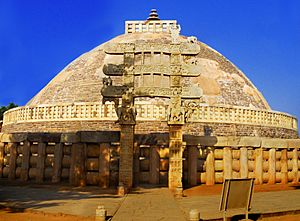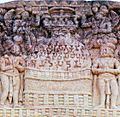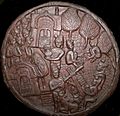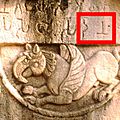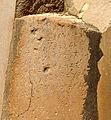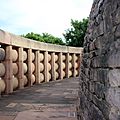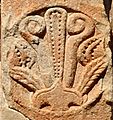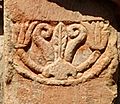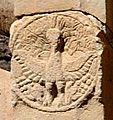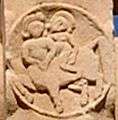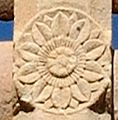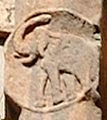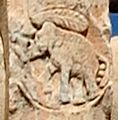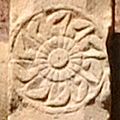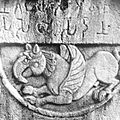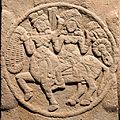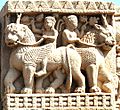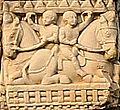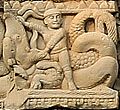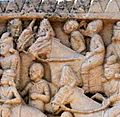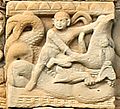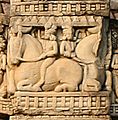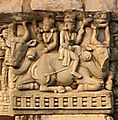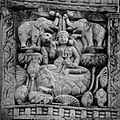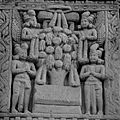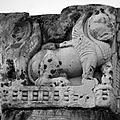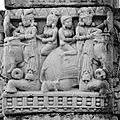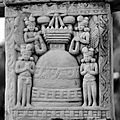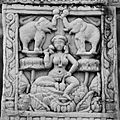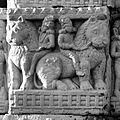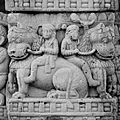Sanchi facts for kids
The Sanchi Stupa is a famous ancient building in India. You can find it in the town of Sanchi, in the state of Madhya Pradesh. It's about 46 kilometers (28 miles) northeast of Bhopal, the capital city. This Great Stupa at Sanchi is one of the oldest stone buildings in India. It's a very important monument for Indian history and architecture.
Emperor Ashoka ordered this stupa to be built way back in the 3rd century BCE. A stupa is like a dome-shaped mound. The first Sanchi Stupa was a simple dome made of brick. It was built to hold and honor the relics (special remains) of the Buddha. On top, it had a chatra, which looked like a parasol. This symbol showed its high importance.
Emperor Ashoka himself watched over the first building work. His wife, Devi, was from a nearby town called Vidisha. Sanchi was her hometown and where she married Ashoka. Later, around the 1st century BCE, four beautifully carved toranas (ornamental gateways) were added. A stone fence, called a balustrade, was also built around the whole structure. The first Sanchi Stupa was made of bricks during the Mauryan period. This important site continued to be used and improved until the 11th century.
Sanchi is also surrounded by other ancient stupas. These include sites like Satdhara, Morel Khurd, and Andher, all just a few miles away.
Contents
What is a Stupa?
A stupa is a special kind of dome-shaped building. It was built to keep important relics of the Buddha or other holy people. These relics could be bones, ashes, or even things they used. Stupas are places for meditation and respect in Buddhism. People often walk around them in a clockwise direction.
Who Built the Sanchi Stupa?
The first part of the Great Stupa was built by Emperor Ashoka. He was a powerful ruler in India during the 3rd century BCE. He became a Buddhist and wanted to spread the Buddha's teachings. Building stupas like Sanchi helped him do this.
Later Additions and Changes
Over many years, the Sanchi Stupa was made bigger and more beautiful.
- Shunga Period: After Ashoka, the Sungas took over. They almost doubled the size of the original brick stupa. They covered it with stone and added a strong stone balustrade (fence) and a railing around it.
- Satavahana Period: Later, the Satavahanas added the famous gateways, called toranas. These gateways are covered with amazing carvings. They tell stories from the Buddha's life and show scenes of everyday life.
What Do the Carvings Show?
The carvings on the gateways (toranas) at Sanchi are like ancient comic books! They show many stories without words.
- Buddha's Life: Many carvings show events from the Buddha's life. But instead of showing the Buddha himself, they use symbols. For example, a wheel might represent his teachings, or a tree might represent his enlightenment. This is called aniconism.
- Jataka Tales: Some carvings tell stories from the Jataka tales. These are stories about the Buddha's past lives.
- Everyday Life: You can also see carvings of people, animals, and plants. They show what life was like in ancient India. Some carvings even show foreigners, which tells us about connections with other cultures.
Important Carvings to See
- Temptation of the Buddha: This carving shows the Buddha's struggle against evil forces.
- War over the Buddha's Relics: This scene shows a fight over the Buddha's remains after he passed away.
- King Ashoka's Visit: One carving shows Emperor Ashoka visiting a place to get relics.
- Foreigners: Look closely, and you might spot figures in foreign clothes, playing different musical instruments. This shows how diverse ancient India was.
Other Buildings at Sanchi
Besides the Great Stupa, there are other interesting buildings at Sanchi.
- Stupa No. 2 and No. 3: There are other smaller stupas with their own unique carvings.
- Temples: You can also see ancient temples, like Temple 17. This temple was built during the Gupta period (around the 5th century CE) and looks like classical Greek or Roman temples.
- Pillars: There are remains of Ashokan pillars with special messages carved on them. One famous pillar has a lion capital, which is now in a museum.
Discovery and Restoration
For many centuries, the Sanchi Stupa was forgotten and covered by nature.
- Rediscovery: In 1818, a British officer named General Taylor rediscovered the site.
- Early Excavations: Later, in the 1800s, archaeologists like Sir Herbert Maddock and Alexander Cunningham explored the site. They found many important artifacts.
- Restoration: In the early 20th century, a major restoration project was started by Sir John Marshall. He carefully rebuilt parts of the stupas and temples. This work helped preserve Sanchi for future generations.
Today, the Sanchi Stupa is a UNESCO World Heritage Site. It is a popular place for tourists and people interested in history and Buddhism.
Images for kids
-
The Great Stupa under the Sungas. The Sungas nearly doubled the diameter of the initial stupa, encasing it in stone, and built a balustrade and a railing around it.
-
Inscription "Vedisakehi daṃtakārehi rupakaṃmaṃ kataṃ" (𑀯𑁂𑀤𑀺𑀲𑀓𑁂𑀨𑀺 𑀤𑀁𑀢𑀓𑀸𑀭𑁂𑀨𑀺 𑀭𑀼𑀧𑀓𑀁𑀫𑀁 𑀓𑀢𑀁, "Ivory workers from Vidisha have done the carving").
-
The Great Stupa at the time of the Satavahanas.
-
Aniconism in Miracle at Kapilavastu: King Suddhodana praying as his son the Buddha rises in the air, praised by celestial beings (but only his path, the horizontal slab in the air, is visible).
-
Foreigners playing carnyxes and aulos flute at Sanchi (detail).
-
Temple 17: a Gupta period tetrastyle prostyle temple of Classical appearance. 5th century CE
-
Inscribed panel from Sanchi in Brahmi script in the British Museum
-
The last two letters to the right of this inscription in Brahmi form the word "dǎnam" (donation). This hypothesis permitted the decipherment of the Brahmi script by James Prinsep in 1837.
-
Sanchi Minor Pillar Edict of Ashoka, in-situ (detail of the previous image).
-
Woman riding a Centaur.
-
Griffin with Brahmi script inscription.
-
Female riding a Centaur.
-
Lakshmi lustrated by Elephants.
-
Statue of Padmapani (5th c.or 9th c.) Victoria and Albert Museum.


